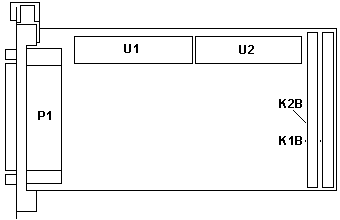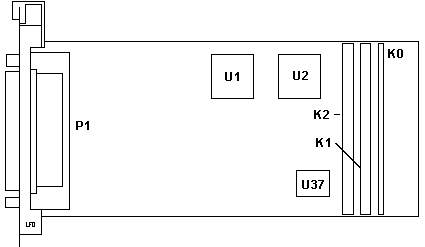|
Multiport/2 or X.25
@eff0.adf Realtime
Interface Co-processor Multiport/2 or X.25 /2 Adapter
Cashing
in on the ARTIC960 caches
IBM
ARTIC Legacy Downloads
Brighton
Component Specification (Used on i960 boards)
Miami
Component Specification (used on i960 boards)
Multiport/2 Base Card PN 16F2200

A Intel A80186
B, D Zilog Z0803606VSC Z-CIO
C, E Zilog Z0803008VSC Z-SCC
CR LED
F 09F1877ESD SSIC
JP1 Jumper Pack |
K1, K2 60 pin socket
SIP1 Dual socket for 30 pin SIMM
U8 BIOS 16F2201
U9 BIOS 16F2203
Y1 14.7456 MHz Osc
Y2 25.0 MHz Osc |
Sorry, but the alpha IDs are made up. I can't see any
markings by the chips....
RS-232 Interface Card ?

K1B, K2B 60 Pin Header
P1 78 pin female Port
U1, U2 Zilog Z80C3008PSC |
Note- K1B is the outermost header.
If you can tell
me what this interface card is... It cane on a Multiport/2 with 512K.
8 Port RS-232-D EIB

K0 30 pin header
K1, K2 60 pin dual header
P1 ?? pin port
U1-U2 SCN26562C4A52
U37 33F5251 3333FF">U37 33F5251
Once again, please tell
me what this is!
30 Pin SIMMS
My sneaky suspicion- these are the same rare chips used by the
SCSI w/cache
512K- Mitsubishi MH25609BJ-12
1MB- IBM 37F2016D 50F8938
LED Indicator
A light-emitting diode (LED) indicator provides a visual
status of the watchdog timer status and error status. The LED turns on
when the watchdog timer expires or a hardware error is detected by microcode
on the co-processor adapter. The LED also turns on when power is applied
initially to the &cop.; it turns off after a successful power-on self-test
(POST).
Co-processor adapter PROM
Two 27C256 chips (200-nS access time) provide the 64KB of co-processor
adapter PROM.
8030 Serial Communications Controllers (SSC)
The primary function of the four SCCs is to provide controller
logic for eight independent serial communications ports.
After initial configuring of the 8030s by the Realtime
Control Microcode, a major portion of the serial communications workload
is relieved from the 80186 processor and is performed by the 8030s
8036 Counter/Timer and Parallel I/O Unit (CIO)
The CIO provides peripheral I/O support through an integrated
chip containing three independent 16-bit counters or timers, two independent
8-bit double-buffered I/O ports, and a special purpose 4-bit I/O port.
One timer and the 4-bit I/O port are used by the on-board
watchdog timer to provide interrupt notification of a run-away CPU or a
run-away operation. Two timers and two ports are used in peripheral I/O
control of data through the co-processor adapter's electrical interface
boards.
The Realtime Control Microcode is the on-board multitasking
supervisory control program (Task 0) for the co-processor adapter. The
program can be found on the Realtime Interface Co-Processor Diagnostics
and Realtime Control Microcode diskette that came with your co-processor
adapter.
Realtime Control Microcode (RCM)
The RCM supports the co-processor adapters through two
versions. Version 1.x is named ICAAIM.COM. It provides support for the
Realtime Interface Co-processor Adapter, the Multiport Adapter, and the
Multiport/2 Adapter. Version 2.x is named ICARCM.COM. It provides support
for the Portmaster Adapter/A and the Multiport Adapter, Model 2.
Watchdog Timer
A watchdog timer has been incorporated on the co-processor
adapter card. This timer, once activated, must continually be strobed by
software so that it will not time out. If the 80C186 processor ever has
a fatal error, this timer will reach its terminal count. The terminal count
will activate an LED indicator on the co-processor adapter card
One timer and one 4-bit I/O port are used by the on-board
watchdog timer to provide interrupt notification of a runaway CPU.
Shared Storage Interface Chip
The SSIC provides a convenient and flexible way of passing data and
control bytes between the 80186 bus and the system unit bus. This is accomplished
through an IBM CMOS gate array called the Shared Storage Interface Chip,
an array of 10,000 gates. The chip adapts to both 8-bit and 16-bit data
buses on the system unit bus. The VLSI gate array's basic purpose is to
provide a high performance interface between the co-processor adapter and
the system unit. All data communications between the system unit and the
co-processor adapter are done through this interface. This is accomplished
through the following functions performed by the Shared Storage Interface
Chip.
Direct Memory Access
The co-processor adapter card has 16 DMA channels dedicated
to the transmit and the receive function of each of eight ports. In addition,
two DMA channels are
assigned to on-card memory-to-memory transfers.
Applications and Information about ARTIC cards
Quadron Corporation
QUADRON ARTIC SOFTWARE
Synchronous
Communications
Flow
Control
ARTIC
Installation Worksheets
Memory
Map to Assist in Shared Window Location
Interrupt
Level Selection
Port Configurations,
Modem Status & Pin Outs
General
Purpose ARTIC Cable
9595 Main Page
|


